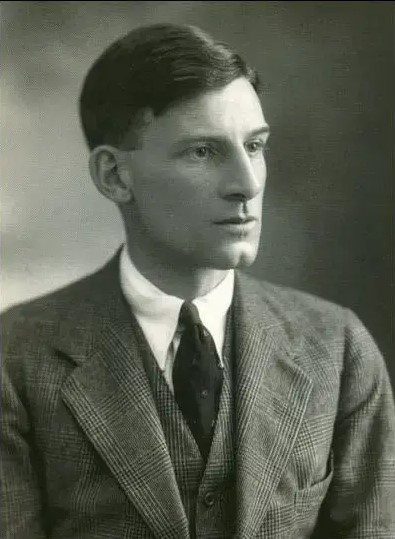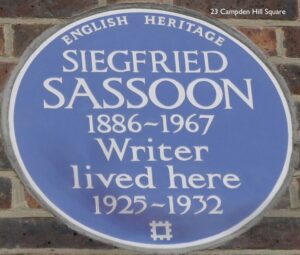JMS Pearce
Hull, England, United Kindom


In the First World War, the writer Siegfried Sassoon (1886–1967) (Figs 1 and 2) received the Military Cross for bringing back wounded soldiers under heavy fire.1 He was admitted to the Craiglockhart War Hospital, Edinburgh in 1917,2,3 where he befriended Wilfred Owen (1893–1918) and described his emotional reactions in “Repression of War Experience”(1918):
Hark! Thud, thud, thud, – quite soft … they never cease –
Those whispering guns – O Christ, I want to go out
And screech at them to stop – I’m going crazy;
I’m going stark, staring mad because of the guns.
He was wont to relate with contempt the horror and brutality of trench warfare. He vehemently impugned generals, politicians, and churchmen for their incompetence and failure to end the First World War. In “Soldier’s Declaration,” he rebuked the “Scarlet Majors” responsible for unnecessary carnage.
Sassoon was born into a wealthy Baghdad Jewish family. Educated at Marlborough College and Clare College Cambridge, he studied history (1905–1907) but did not graduate. Wilfred Owen (1893–1918) (Fig 1) too, told with irony of his terrifying experience at the front in a poem entitled “Dulce et decorum est,” taken from the Roman poet Horace’s “Dulce et decorum est Pro patria mori”: “it is sweet and fitting to die for one’s country.” Owen’s poem was written at Craiglockhart and published posthumously in 1920. Often regarded as the outstanding poet of that war, Owen published other heart-rending verses, including Anthem for Doomed Youth:
What passing-bells for these who die as cattle?
— Only the monstrous anger of the guns.
Only the stuttering rifles’ rapid rattle
Can patter out their hasty orisons …
A close friend of Sassoon, Owen was returned to the front line after treatment at Craiglockhart and was killed in France on November 4, 1918. He was posthumously awarded the Military Cross for his actions on October 1, 1918 for taking a German machine-gun position.
Shellshock and Craiglockhart
Shellshock, often called neurasthenia, was thought by many to be a cowardly escape from the horrendous conditions in the trenches by malingering or swinging the lead (sometimes described as plumbitis swingerans). Sassoon wrote:
After the War Rivers told me that the local Director of Medical Services nourished a deep-rooted prejudice against [Craiglockhart], and actually asserted that he “never had and never would recognize the existence of such a thing as shell-shock.”
Similar accounts of brutal inhumane treatment were recounted in the famous novel England, Their England by AG Macdonnell (Macmillan, 1936), who was a patient at the hospital from April 1918.
Craiglockhart, nicknamed “Dottyville,”4 opened in October 1916. Major William Bryce, a local physician, was commanding officer. WHR Rivers was seconded as an eminent physician with experience at Maghull Hospital for shellshocked officers and soldiers, along with Arthur John Brock, an Edinburgh physician. Brock had treated neurasthenia before the war and introduced an enlightened behavioral approach, which he termed “ergotherapy” or cure by functioning. This provided sports, entertainment, teaching, training, and jobs with farmers. He founded The Hydra, the hospital magazine, edited by Wilfred Owen, in which patients freely recounted their experiences and sentiments in short articles, poems, and cartoons.
Between October 1916 and March 1919, 1736 patients with shellshock were treated at the hospital.2 Many were transferred to other hospitals or to “light duties.” Only a few were returned to active duties at the front. Many remained psychologically damaged. One poem in The Hydra records:

Craiglockhart memories will be sad,
Your name will never make us glad;
The self-respect we ever had
We’ve lost—all people think us mad.
Sassoon suffered from shellshock, a term introduced by Myers in 1915.5 He was fortunate in being treated by WHR Rivers MD FRS, a distinguished but shy, introverted physiologist, anthropologist, and psychologist6 who also treated Wilfred Owen. Sassoon’s fictionalized autobiography, The complete memoirs of George Sherston (1980), extols Rivers as a hero who saved his life and soul. In his preface to Medicine, Magic and Religion (1924), Sassoon wrote:
I would very much like to meet Rivers in the next life. It is difficult to believe that such a man as he could be extinguished.
Sassoon was a cricket and fox-hunting enthusiast and was encouraged by Owen to write poetry.7 He was also well known as a novelist and political commentator. He had affairs with several men in the 1920s but married Hester Gatty in 1933, and they had a son, George, who became a scientist, engineer, and linguist. After many years the marriage ended in separation.
In 1957 he was awarded the Queen’s Medal for Poetry.7 He was made CBE in 1951 and died of stomach cancer in 1967. Owen was killed in action seven days before war ended at 11 am on November 11, 1918.
References
- Sassoon S. The Complete Memoirs of George Sherston. 1980. [Sassoon’s trilogy of fictionalized autobiography]
- Webb TE. ‘Dottyville’ — Craiglockhart War Hospital and shell-shock treatment in the First World War. JR Soc Med. 2006;99(7):342-6.
- Slingerland A. Craiglockhart Hospital, head above the parapet. Hektoen Int Spring 2015.
- Weatherdon G. The Craiglockhart War Hospital of Edinburgh. Hektoen Int Winter 2015.
- Myers CS. A contribution to the study of shell shock: being an account of three cases of loss of memory, vision, smell and taste admitted into the Duchess of Westminster’s War Hospital, Le Touquet. Lancet 1915;1.
- Pearce JMS. William Halse Rivers Rivers (1864-1922) and the Sensory Nervous System. Eur Neurol 2008;60:208-11.
- Siegfried Sassoon. Poetry Foundation. https://www.poetryfoundation.org/poets/siegfried-sassoon.
JMS PEARCE is a retired neurologist and author with a particular interest in the history of medicine and science.

Leave a Reply